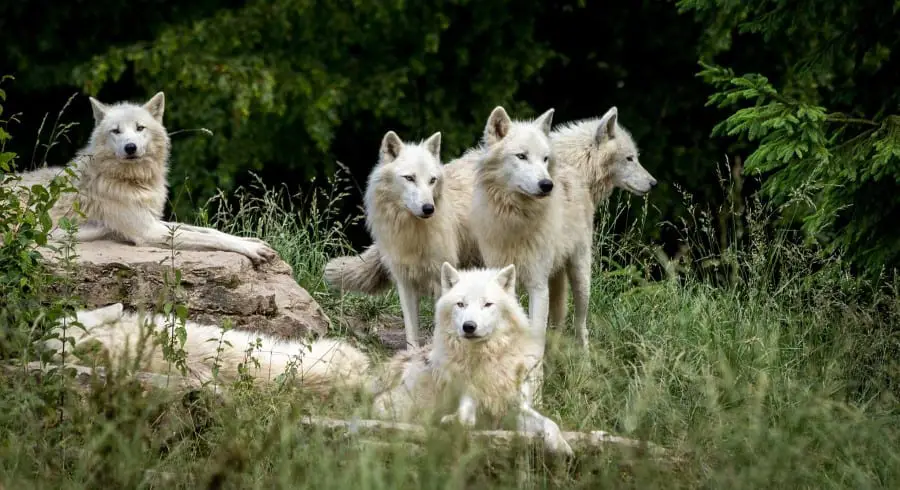Here are 20 must-know facts about the Arctic Wolf. Help understand and preserve these wonderful creatures by learning more about them.
Read on, or check out the video at the base of the article. From that Ranger Planet YouTube Channel.
1. Other Names for Arctic Wolf
The Arctic wolf is also known as Polar Wolf or White Wolf. Mainly as it has a familiar-looking snowy white fur to it.
2. Scientific Classification
The Arctic Wolf’s scientific name is “Canis lupus arctos“, these wolves belong to the “Canidae” family of carnivores and the Arctic wolf is a subspecies of the famous Grey Wolf.
- Kingdom: Animalia
- Phylum: Chordata
- Class: Mammalia
- Order: Carnivora
- Family: Canidae
- Genus: Canis
- Species: C. lupus
3. Habitat
Arctic wolves thrive in the arctic tundra ecosystem. The land where they live is usually always covered by ice and snow, except for a short period of the summer season. They spend much of their time traveling their territory to seek out prey, only remaining in one area to rear their young.
4. Distribution
Wolves are present in North America, Canada, Greenland, and within the central mass of Asia.
Due to human involvement, their population has vastly decreased from areas like Europe, but they are equally present in the areas of Alaska where the human population is much lower – they thrive in areas with more extreme weather and where the human population is therefore fewer.

5. Evolution
According to scientists, Arctic wolves evolved 50 million years ago from other families of canines. At the time of the Ice Age, wolves were forced to survive in what would then be colder regions, which then naturally led to their adaptation into that environment.
6. Physical Appearance
Also, when they’re born they have blue irises, these gradually change to yellow-gold or orange as the pups grow. The color of the fur of an adult Arctic wolf is white.
At the time of birth, Arctic wolf pups also generally have darker fur than adult wolves and can appear brown in color.
Physically, Arctic Wolves are smaller than other subspecies such as grey wolves, their muzzle is shorter and their ears are also smaller and more rounded. This all serves to reduce exposure to cold temperatures.
The average wolf measures 41-65 inches (105–165 cm) in length and 31-33 inches (80–85 cm) across the shoulder. With the tail measuring around 11-20 inches in length.
Arctic wolves are bulkier than their relatives (grey wolves) and can weigh between 100 to 170 pounds. Females in most wolf geographical populations typically weigh 5–10 lb (2.3–4.5 kg) less than the males.
7. Communication
The Arctic Wolf communicates with the help of various voicing sounds, and the position of its tail.
They howl to ward off other packs from their territory, a wolf howl can travel long distances in the wild. They also use it to locate themselves to other pack members, and for other communications reasons too.
Howling also has the effect of creating a community spirit within the pack, which is why they often howl in unison. Often this happens first thing in the morning and Pups will try to join in too.
Sometimes a chorus of howling can often precede a hunt for food. A rally cry to the pack.
Like many dog species, wolves position their bodies and their tails to indicate emotional and behavioral signals; such as being aggressive and showing their teeth, growling, and tail up or swaying, through to more permissive stances, with ears folded back and their bodies lowering closer to the floor.
8. Diet
Arctic wolves are apex predators and are carnivores. They eat a wide variety of food available in their territory. Their main sources of food are musk-oxen and caribou which they usually stalk and hunt in packs.
However, they can also eat ptarmigan (a pheasant-like bird), seals, lemmings (small rodents), Arctic hares, and other small animals and birds.
9. Hunting
Arctic wolves hunt in the form of a pack. They work as a unit during a hunt. Moreover, one adult member will always remain behind to look after the younger members of the pack. They travel a lot in the search of food, and sometimes in harsh times, they can go for days without food.
Wolves have very keen senses, their keen eyesight, acute hearing, and a great sense of smell help them to locate potential prey – even over some distance.
The alpha male and/or female will often set out on hunts along with some or all of the subordinate members and can travel over many miles in search of prey. Once found they will work together to bring down any larger prey.
Once caught, the Alpha members will eat first, and even though other pack members helped catch the prey, they will almost have to beg to be able to feed on the animal.
If there’s a lot of food leftover afterward, chunks will often be buried in the cold tundra as a food store which could be available once the winter sets in.
Injuries permitting, they will then head back to the den
10. Territories
Arctic wolves generally live in ecosystems where food can be scarce, therefore, they can cover large territories.
During winter, when temperatures are at their lowest, and their prey (like caribou) migrate, they will often follow them through the territories, this traveling can take them across 1000 miles of terrain at a time. Often bringing them closer to human civilizations to look for food, but they do not generally come close enough to be hunted.
11. Endurance
Arctic Wolves have great stamina, they can travel anything up to ten hours a day, covering up to forty miles over smooth terrain, and for up to ten hours to search out potential food.
Over a short distance, and mainly when hunting, Arctic wolves can run at speeds recorded at 40 miles per hour (64.4 km per hour). This fast speed and quick acceleration enable them to catch a lot of fact prey, particularly with the element of surprise and within close proximity.
12. Physical Strength
Arctic wolves have 42 sharp teeth lining their mouths that have evolved to tear flesh and crush the bones of their prey. Their bite force can reach up to 600 psi.
Along with their bite force, they also have powerful paws to bring down and pin their prey. An average human male, without any weapon, would find it difficult to defend against a single wolf attack. And certainly cannot defend against more than one, so caution is advised.
13. Breeding/Mating
In an Arctic wolf pack, only the alpha male of the pack is allowed to mate with the beta female, however, in large packs, other members may mate (but this is not common).
The Female wolf has a gestation period averaging around 63 days. Females mate with a male at the end of March or in early April. On average, females give birth to 2 to 4 pups at a time anywhere from late May to early June when the temperature is favorable.
14. Pup’s Care
Female Arctic wolves usually give birth to their young ones in a warmer ‘den’ built into a Rocky outcrop, or in the hollow of a cave. Mothers are very protective toward their pups and don’t allow any other pack members to come into the den until at least the pups open their eyes, which could take up to two weeks. Mothers wean their pups two months after birth.
Pups are fed the regurgitated food of their pack members until they reach 6 months of their age and are then able to travel with their pack. Female pups mature at the age of two years, while males mature after one year.
When growing, pups will play for hours, this provides exercise, helps strengthen muscles, and for practice in becoming an adult. Playing over an old bone this time could be fighting over a carcass later. So the play can gradually turn to more boisterous games.
Pups can wander up to half a mile from their mother, but the mother will bring them back toward the pack when needed.
15. Social Behaviour
Arctic Wolves are very social in behavior. Each member of the pack knows its status in the group and its place within a complex hierarchical social order.
Alpha males lead the pack and other members follow the alpha male. Their pack may contain from five to eight members or more. They don’t stay at a particular place permanently and always travel – mainly in search of food; the longest stay they make in any one place is during the season of pup care.

16. Temperature Fluctuations
Arctic wolves live in one of the most inhospitable territories on earth. The area where these wolves live often has a freezing temperature of -22 Fahrenheit.
The conditions can even get harsher in winters when temperatures drastically decrease to less than -22, with no sun for months.
17. Adaptations in the environment
They have two thick layers of fur on their bodies to compete in such a drastic environment. The outer layer of an Arctic wolf’s fur is completely hydrophobic, which acts as a barrier between ambient temperature and its body.
Along with this type of skin Arctic Wolves also have blubber fat under their skin. So they can maintain their body temperature even in these harsh conditions.
They also have smaller ears than their other relatives, this serves to minimize heat loss. Also, their padded paws not only save them from cold temperatures but also help them in reducing friction between their paws and frozen land.
18. Life Expectancy
Arctic Wolves can enjoy seven to ten years of life in the wild. However, their life duration increases in captivity, up to a potential of 17 to 20 years, mainly due to fewer threats, injury risks, and general survival than living in the wild.
19. Population
The population of the Arctic wolf is about 200,000 individuals. At present, they’re listed under the category of Least Concern (LC) in the “Red List” of IUCN.
20. Population Threats
Arctic wolves rarely come into contact with humans, due to their extreme weather enduring abilities. So, the direct threat from hunting or culling by humans is minimal.
However, their habitat has been disturbed in many places over the centuries, which has led to a retreat of potential territory and breeding grounds. And also, their food sources have been reduced.
Learning Resources
Want to learn more about Wolves? Indulge your love of wolves and get educated further with these fascinating books on Amazon.
The Hidden Life of Wolves
Wolves: Behavior, Ecology, and Conservation
Video Resource
Here’s the video that echoes the above 20 facts about arctic wolves.
To finish up…
These fascinating and yet largely hidden creatures are not on the endangered list, at least not yet. It’s important we keep it that way. Learn more about all types of wolves, respect their habitat and keep them safe.
